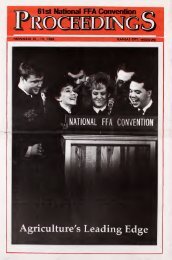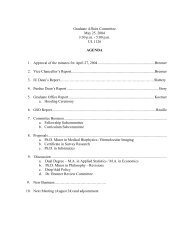You also want an ePaper? Increase the reach of your titles
YUMPU automatically turns print PDFs into web optimized ePapers that Google loves.
Tree Talk<br />
by<br />
Thouglit you folks might be interested in some<br />
treeplanting facts I ran across the other day.<br />
Did you know, for instance, that the first record<br />
of reforesting fire-scarred acres for commercial<br />
purposes was in Germany more than 600 years<br />
ago? It's true!<br />
Our own government first started experimenting<br />
with the planting of live oaks in 1827.<br />
Since then, tree planting has become big prof-<br />
itable business, especially with the shift in<br />
emphasis from planting on public to private<br />
lands. Authorities report that one billion trees<br />
were planted in the U.S. last year! 86% of this<br />
was done on private lands.<br />
What does that mean? It means a big hungry<br />
market for pulpwood and saw logs. And that<br />
kind of market means plenty of profits in tree<br />
farming. Something to think about, isn't it?<br />
Something else to think about is how to pro-<br />
tect your Tree Farm from insects and diseases.<br />
Best way of all is to keep your stand in a<br />
thrifty growing condition by constant careful<br />
thinning.<br />
Bark beetles, for instance, will quickly go to<br />
work on any injured wood. Best defense against<br />
these rascals is to cart the salvageable materials<br />
to a mill, burn the unsalvageable material,<br />
and spray the stand with benzene hexachloride<br />
solution.<br />
Another common insect pest is the Nantucket<br />
pine tip moth, which specializes in loI)lo]ly and<br />
shortleaf pine. Protect seedlings from this pest<br />
by dipping them in 1% white oil emulsion.<br />
During moth emergence, spray infected trees<br />
with 1% DDT.<br />
Then there's oak wilt, particularly damaging<br />
to rerl, black and white oak. You can spot this<br />
one by the curling and loss of color of older<br />
leaves in the crown and a gradual shedding of<br />
the leaves. Left alone, the trees will be dead in<br />
a year or two. To control and check the infection,<br />
cut root connections between the diseased<br />
and healthy tree.s.<br />
Vines are serious pests in some sections<br />
because they cut off light and use up the moisture.<br />
To get rid of them, paint the vines close<br />
to the base with 2, 4, 5-T.<br />
Last few months I've been doin^ .so niiich<br />
talking about the low-pri
















